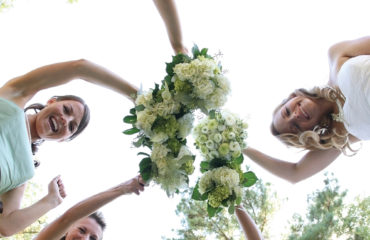Ask Martha: Wedding Etiquette, from Planning to the Big Day

Wedding wisdom and practical solutions for all your pressing questions.
Q: I love the way my diamond engagement ring catches the light when it’s clean. How do I keep it that way? Is it a bad idea to shower with it on?
A: Not only will bathing with your ring not hurt it, it’ll help, says Martha Stewart Weddings senior style editor Melissa Colgan: “A little sudsing keeps it sparkling.” Just be mindful that heavy conditioners and soaps can gunk up the setting, so be sure to rinse your ring finger with fresh water post-shower. To maintain a diamond’s shine and keep the prongs clear, mix a few drops of mild dish soap with water, rub it onto the ring with a soft-bristle toothbrush, and rinse. Done monthly, this DIY solution works as well as store-bought jewelry cleaner (but only on diamonds, sapphires and rubies; softer stones like emeralds and amethysts may become damaged by brushing). Visit your jewelry store once a year for an ultrasonic cleaning as well. If that’s where the ring was purchased, the service is usually free, and, Colgan adds, “the jeweler will also inspect the stone, band and setting to check that nothing is awry.”
Q: My fiancé and I have been dating for eight years, but our families have never met. We’re getting everyone together in three weeks for the first time. Is a simple dinner OK, or should we plan more of a to-do?
A: No need to stress out or get too fancy: “A simple dinner sounds perfect—emphasis on the simple,” says Martha Stewart Weddings executive editor Eleni N. Gage. The goal is to have your families feeling relaxed enough to mingle and chat freely. One way to do that, Gage says, is by making the meal something of an activity, which can help break the ice (think barbecue at an Argentine restaurant or dim sum at a Chinese one). You could also extend the length of a traditional supper so people have more of a chance to talk —suggest a round of appetizers to share or dessert for the table. If you’re hosting at home, set out wine and cheese before bringing out the lasagna (again, keep it simple—no sweating over soufflés for the first in-laws encounter). And if both sets of relatives are coming from out of town, hand them a list of fun things to do in the area as a nice gesture. “Who knows?” Gage adds. “By the end of the evening, they might be planning excursions together!”
Q: I’d like to introduce our wedding party at the reception, but my fiancé thinks it’s cheesy. Is there a good alternative?
A: While we enjoy watching goofy videos of over-the-top grand entrances, we know not every couple is looking to be the next YouTube sensation. And if one of you is more reserved than the other, prancing out to something from Jock Jams isn’t going to add up to the wedding of your dreams. Nevertheless, “there are other ways to give your attendants their due,” says Weddings contributing editor David Stark, of David Stark Design and Production in New York City. He suggests taking a cue from Broadway playbills by including a who’s who on the backs of dinner menus left at each place setting. “Print small bios of each player alongside their picture, but use candids or illustrations instead of head shots and quirky text in lieu of a serious résumé,” he says. “It’s a fun way to introduce your ‘cast.’”
Q: My mom wants me to send announcements to relatives who weren’t invited to our wedding, but I’ve never gotten one. Is it appropriate to do so?
A: “It’s less common in this age of Facebook, Twitter and Instagram, but popping announcements in the mail after the fact is still the polite way to let people know that you got hitched,” says Weddings senior editor Julie Vadnal. It’s more personal than an email blast and a nice idea to reach out to those relatives and acquaintances who weren’t on the guest list but would want to be informed of your marriage. Mailed announcements, which can be as simple as a handwritten note or as formal as a printed card, are also a great way to spread the word if you eloped or had a very small gathering. And in case you were wondering, anyone who gets one is in no way obligated to send a gift.
Ideally, you’d mail these the day after your wedding; if you’re leaving for your honeymoon right away, have them stamped and ready to go, and ask a friend to drop them in the postbox for you. If that’s not possible, send them out within three months of the red-letter date, before the happy news becomes old news.
Q: My fiancé and I aren’t having a traditional wedding – we’re going to the courthouse and then out to dinner with our parents. I’m not wearing a white gown, but I love the romance of a bird cage veil. Will I look like an idiot in one?
A: Not at all! In fact, Martha Stewart Weddings associate fashion editor Carrie Goldberg says she prefers a bird cage with a knee-length dress or suit, rather than a floor-grazing gown, because the short veil/short dress combo is more proportional. The key to pulling off the look, Carrie says, is to select a headpiece that relates to the colors and fabric that you’re wearing from the neck down. Which means, for example, that you don’t have to automatically default to a white veil just because it’s your wedding. Consider a headpiece that picks up on whatever shades are in your outfit. Or, if you love the way two contrasting hues look together, go ahead and pair them, but make sure the materials are complementary: If you’re wearing a tweed suit, for instance, opt for a headpiece with leather trim, not gauzy flowers.
Q: How do we decide whom to invite to our engagement party? I’d like to include people who might not be invited to the wedding since that will be a small destination affair.
A: Originally, engagement fêtes were intimate events, hosted by the bride’s parents and meant only for relatives and close friends; it was a no-brainer that everyone who attended would also be at the big day. Now, the etiquette is changing as more couples are hosting their own larger gatherings. It’s still easiest if everyone at the kickoff celebration makes the list later, so no one feels awkward or left out. But, as Martha Stewart Weddings senior editor Julie Vadnal says, “It’s OK to bend this rule if you’re having a tiny wedding. Just be clear that this is the case, or people will be left waiting in vain for their invites.”
Q: My two daughters are marrying seven weeks apart, and they’re each other’s maid of honor. They both live away from home, and the wedding is in our home town. Is it OK to have one joint bridal shower? And can they serve as hosts for each other?
A: Logistically, combining both events into one would make sense. “But the sticky issue here is with the guest list,” warns Vadnal, who points out that having a two-for-one shower works only if everyone who comes is invited to both weddings; otherwise, partygoers will feel compelled to bring presents for a bride whose celebration they’re not attending. In the case of your daughters, they do share family, but their friend groups may not overlap. If that’s true, one way to work around the situation is for you to host a joint, family-only shower in your hometown, so relatives (and the brides) travel for just one party. Then, for those who aren’t going to both nuptials, “Separate low-key celebrations, like fun girls’ dinners or brunches or a day at the beach, can be organized by each maid of honor,” Vadnal suggests. Those, your daughters can absolutely host for each other.
(Reported by Jaime Buerger) Got a question? Email us at askmartha@marthastewartweddings.com. Distributed by The New York Times syndicate.



